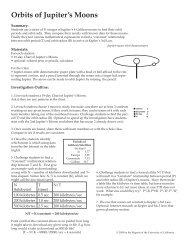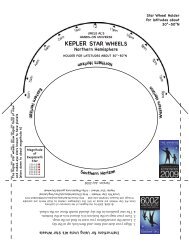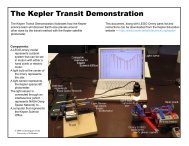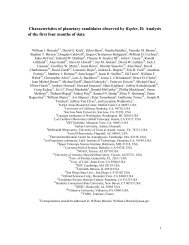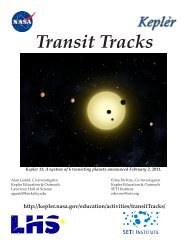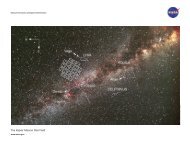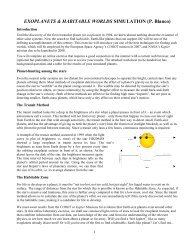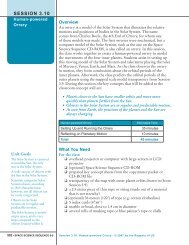Poster Abstracts - Kepler - NASA
Poster Abstracts - Kepler - NASA
Poster Abstracts - Kepler - NASA
- No tags were found...
Create successful ePaper yourself
Turn your PDF publications into a flip-book with our unique Google optimized e-Paper software.
POSTER ABSTRACTSP0704. POSTER SESSION IICycle 1 Observations of Low Mass Stars: New Eclipsing Binaries, Single Star Rotation Rates, and the Natureand Frequency of Starspots Thomas E Harrison 1, , J. L. Coughlin 1 , Nick M. Ule 1 , and Mercedes Lopez-Morales 2 ,1Astronomy Department, New Mexico State University, Las Cruces, NM 88003, tharriso@nmsu.edu, jlcough@nmsu.edu,nmule@nmsu.edu, 2 Institut de Ciencies de L'Espai (CSIC-IEEC), mlopez@ieec.uab.esIntroduction: We have analyzed <strong>Kepler</strong> lightcurves for 849 stars with T eff ≤ 5200 K from our Cycle1 Guest Observer program. We identify six new eclipsingbinaries, one of which has an orbital period of29.91 d, and two of which are probable W UMa variables.In addition, we identify a candidate “warmJupiter” exoplanet. We further examine a subset of 670sources for variability. Of these objects, 265 starsclearly show periodic variability that we assign to rotationof the low-mass star. At the photometric precisionlevel provided by <strong>Kepler</strong>, 251 of our objects showed noevidence for variability. We were unable to determineperiods for 154 variable objects. We find that 79\% ofstars with T eff ≤ 5200 K are variable. The rotation periodswe derive for the periodic variables span the range0.31 ≤ P rot ≤ 126.5 d. A considerable number of starswith rotation periods similar to the solar value showactivity levels that are 100 times higher than the Sun.This is consistent with results for solar-like field stars.As has been found in previous studies, stars with shorterrotation periods generally exhibit larger modulations.This trend flattens beyond P rot = 25 d, demonstratingthat even long period binaries may still have componentswith high levels of activity and investigatingwhether the masses and radii of the stellar componentsin these systems are consistent with stellar models couldremain problematic. Surprisingly, our modeling of thelight curves suggests that the active regions on thesecool stars are either preferentially located near the rotationalpoles, or that there are two spot groups located atlower latitudes, but in opposing hemispheres.2011 <strong>Kepler</strong> Science Conference - <strong>NASA</strong> Ames Research Center 187



